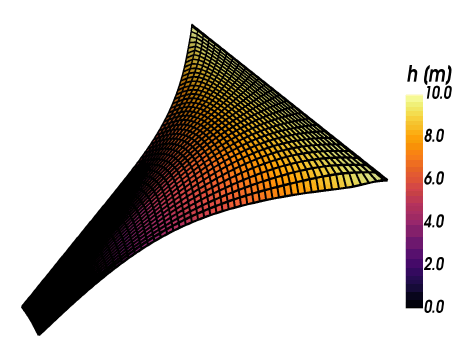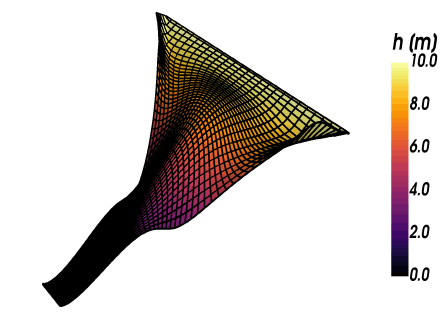H.M. Schuttelaars1, T. Boelens2, T. De Mulder2, X. Deng1 and Tian Qi2
1 Delft Institute of Applied Mathematics, Delft University of Technology, The Netherlands.
2 Hydraulics Laboratory, Civil Engineering, Faculty of Engineering and Architecture, Ghent University,
Belgium.
Introduction
Complex bottom patterns are often observed in tidal basins, found in for example the Wadden Sea along the Dutch, German and Danish coast. These patterns consist of branching channel-shoal patterns, that often exhibit cyclic behavior. Using an idealised morphodynamic model, we aim at directly finding morphodynamic equilibria and assess their stability, with a specific focus on their sensitivity to Coriolis forcing and planform geometry.
Methods
The physics are modeled using the depth--averagerd shallow water equations, suspended sediment transport equation and the bed evolution equation. As a first step, the equations are scaled, using typical order of magnitudes for the various physical parameters. After scaling, a small parameter is identified, namely the ratio of the amplitude of the sea surface elevation and the water depth at the seaward side. This allows for an asymptotic analysis of the system of equations, resulting in a systematic solution method to obtain the various physical variables. Since the water motions and sediment transport take place on a much shorter timescale than the bed evolution, the bed is considered fixed on the fast hydrodynamic timescale. Only the tidally averaged divergences and convergences of the sediment transport result in a change of the bed profile on the long timescale. The model equations are discretized using the finite elements method, and morphodynamic equilibria are obtained using a continuation method: instead of integrating the equations in time, a solution of the equations is sought for such that there are no convergences and divergences of tidally averaged sediment transport. By including the Coriolis force and a general planform, results reported in the literature are extended.
Results
As an example, two equilibrium bed profiles are shown in the figure below: one for an exponentially diverging single tidal inlet (left panel) and one for a more realistic geometry (right panel). In both cases, the water depth at the seaward side (lefthand side) is maximum, while the undisturbed water depth vanishes at the landward side. In the equilibrium bathymetry shown in the right panel, the presence of a channel-shoal system is observed that is forced by the planform geometry.


Figure 1 Two examples of morphodynamic equilibrium in single inlet systems
In this presentation, the influence of the planform geometry and Coriolis forces on the morphodynamic equilibria and their linear stability will be systematically analysed and the underlying physical mechanisms will be explained.
I. Surname1*, F.N. Another-Surname2 , Y. Next-Surname2
1 University Name, Country; 2 Organization Name, Country
* Corresponding author: mail.name@organization.org


